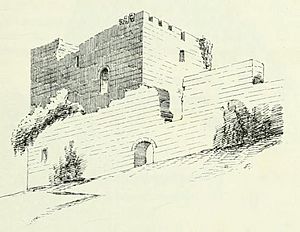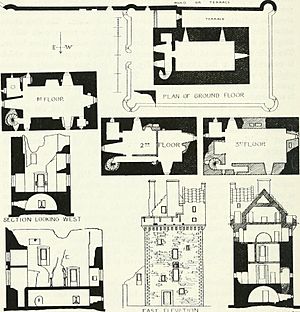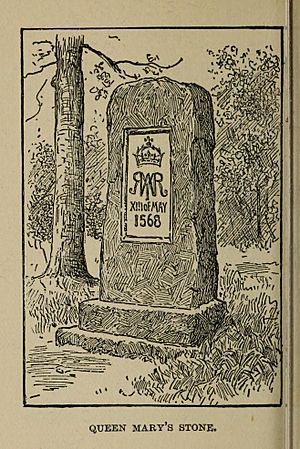Cathcart Castle facts for kids
Cathcart Castle was an old castle from the 1400s. It was located in what is now Linn Park in southern Glasgow, Scotland. People stopped using the castle in the 1700s. The last parts of the castle were taken down in 1980. Now, only its foundations can be seen.
Contents
History of Cathcart Castle
The Cathcart family owned the land here since the 1100s. In the mid-1400s, the family leader became a noble, known as Lord Cathcart. It is thought that the castle was built around this time.
In 1546, the castle became owned by the Semple family.
Mary, Queen of Scots and the Battle of Langside
There is a famous story about Mary, Queen of Scots, staying at Cathcart Castle. It says she spent the night before the Battle of Langside (1568) there. The story also claims she watched the battle from a nearby hill.
However, this is probably not true. The Semple family, who owned the castle, were against Queen Mary. They would have captured her if she had come there. Also, the hill mentioned, Court Knowe, was too low to see the battle clearly. A better spot to watch would have been Prospecthill.
Another story says Queen Mary stayed with her relatives, the Stuarts of Castlemilk. Their strong home had a room called Queen Mary's Room. This room supposedly had the Stuart family crest on its ceiling. But this is also unlikely. Mary had spent the week before the battle gathering 6,000 troops in Hamilton.
Later Years and Demolition
In 1740, the Semple family built a new house nearby called Cathcart House. They moved out of the castle, and it slowly fell into ruin.
In 1814, the 1st Earl Cathcart bought back the old family castle. He planned to sell its stones for other buildings. By 1866, the castle still had five floors standing. It was surrounded by other small buildings.
In 1927, Glasgow City Council bought the land around the castle. They added it to Linn Park. In 1980, the remaining parts of the castle were considered unsafe. The council pulled them down. Today, the castle site is a Scheduled Monument. This means it is a special historical place protected by law.
Castle Design
The castle was built on a rocky bank next to the White Cart Water. It was a rectangular tower house, about 15.5 by 9 metres (51 by 30 ft). It had five floors, including a basement with a strong arched ceiling.
A strong wall, called a curtain wall, surrounded the tower. This wall enclosed a small yard known as a barmkin, about 22 by 15 metres (72 by 49 ft). The tower stood in the middle of this yard. The curtain wall had round towers at its corners. It also had a gatehouse with two towers on the east side.
Today, only the foundations of the tower house remain, about 1 metre (3 ft) high. Some earth mounds to the west of the castle might be the remains of an outer yard or another defensive area.




